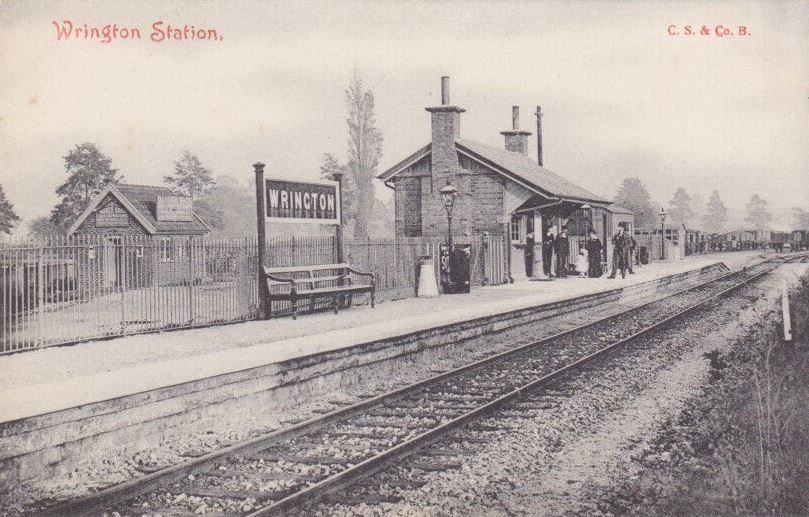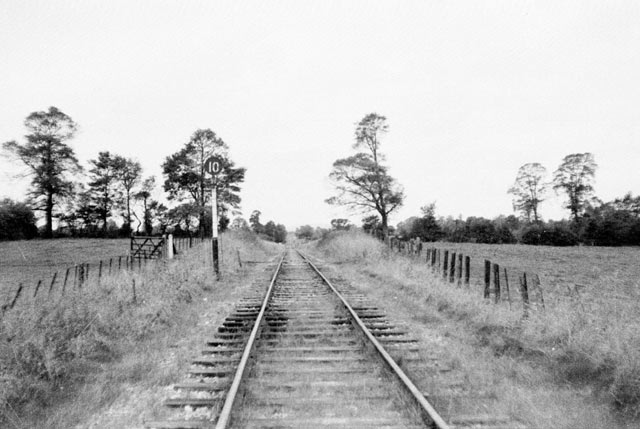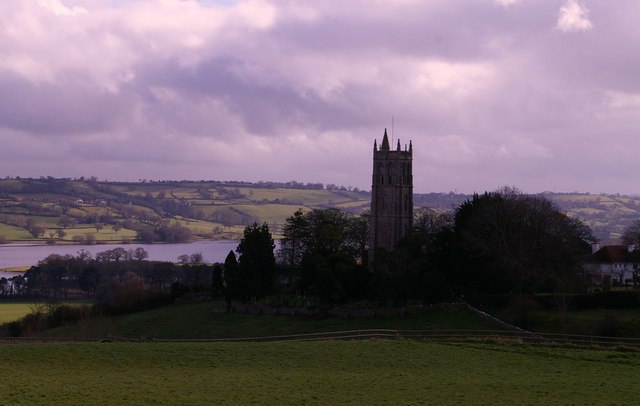|
Wrington Railway Station
Wrington railway station was a station at Wrington on the Wrington Vale Light Railway, which ran from Congresbury to Blagdon, in Somerset ( en, All The People of Somerset) , locator_map = , coordinates = , region = South West England , established_date = Ancient , established_by = , preceded_by = , origin = , lord_lieutenant_office =Lord Lieutenant of Somerset , lord_ ..., England. The station was opened on 4 December 1901 as a single-platform station. The station provided a service to passengers up until 14 September 1931, mostly to Bristol via Congresbury. In 1926 on Mondays a train would leave Wrington at 7:38 for workers needing to reach Bristol before business hours. Competition from the direct bus service via the A38, caused a steep decline in passengers numbers. The line from Blagdon to Wrington closed in 1950 but the line to Wrington was still in use carrying goods (chiefly coal) until closed completely on 10 June 1963. Since closure The platfor ... [...More Info...] [...Related Items...] OR: [Wikipedia] [Google] [Baidu] |
Wrington
Wrington is a village and a civil and ecclesiastical parish on the north slopes of the Mendip Hills in North Somerset, England. Both include nearby Redhill. Wrington lies in the valley of the Congresbury Yeo river, about east of Weston-super-Mare and south-east of Yatton. Its population of 2,633 at the 2011 Census was estimated in 2019 to be 2,759. History The village was inhabited in Roman times and there is evidence of Saxon occupation as well. Historically it was part of the hundred of Brent-cum-Wrington. Wrington Cottage Hospital opened in 1864, initially for 24 patients. The first surgeon was Horace Swete, author of the ''Handy Book of Cottage Hospitals'', to which Florence Nightingale also referred in 1869. Wrington had a railway station between 1901 and 1963, on the Wrington Vale Light Railway that ran from Congresbury to Blagdon. Governance As a parish council, Wrington's sets an annual precept for operating costs and produces annual accounts for public ... [...More Info...] [...Related Items...] OR: [Wikipedia] [Google] [Baidu] |
Wrington Vale Light Railway
The Wrington Vale Light Railway was a railway from Congresbury on the Cheddar Valley line to Blagdon, and serving villages in the Yeo Valley, North Somerset, England. Construction of the line started in 1897 and it opened in 1901. Never more than a purely local line, it closed to passengers in 1931, and completely in 1963. History Construction The first attempt to build a railway line in this part of North Somerset took place in 1882, when an Act was obtained (on 18 August) incorporating the Radstock, Wrington & Congresbury Junction Railway, which was to run from Farrington Gurney on the Bristol and North Somerset Railway to Congresbury through Wrington. However sufficient capital could not be raised, and the company was dissolved in 1886. The Light Railways Act of 1896 was passed with the intention of enabling low-cost local railways to be built, and a line from Blagdon to Congresbury was promoted. At this time the Bristol Waterworks Company were building a reservoir at B ... [...More Info...] [...Related Items...] OR: [Wikipedia] [Google] [Baidu] |
Congresbury
Congresbury is a village and civil parish on the northwestern slopes of the Mendip Hills in North Somerset, England, which in 2011 had a population of 3,497. It lies on the A370 between Junction 21 of the M5 and Bristol Airport, south of Bristol city centre, and east of Weston-super-Mare. The Congresbury Yeo river flows through the village. The parish includes the hamlet of Brinsea. The nearest railway station is Yatton, with trains provided by Great Western Railway, but Congresbury once had its own railway station on the Cheddar Valley Line from Yatton to Wells. It was also the starting point for the Wrington Vale Light Railway, which went to nearby Wrington and Blagdon. History Congresbury is named after St Congar, who is said to have performed three miracles in the area. The second part of the name is thought to come from ''burh'' meaning fortified place. The remains of an Iron Age hill fort at Cadbury Hill have been discovered, as well as a Roman villa, temple an ... [...More Info...] [...Related Items...] OR: [Wikipedia] [Google] [Baidu] |
Blagdon
Blagdon is a village and civil parish in the Ceremonial counties of England, ceremonial county of Somerset, within the unitary authority of North Somerset, in England. It is located in the Mendip Hills, a recognised Area of Outstanding Natural Beauty. According to the 2011 United Kingdom census, 2011 census it has a population of 1,116. The village is about east of Weston-super-Mare on the A368 road, A368 between Churchill, Somerset, Churchill and Compton Martin. History The village was called ''Blachedon'' in the 1086 Domesday Book and the name comes from the Old English ''bloec'' and ''dun'' meaning 'the black or bleak down'. Romans There was a Roman Empire, Roman presence in Blagdon from about 49 AD until the end of the Roman occupation of Britain. Several Roman coins and fragments of Roman pottery have been found in the village. There were lead and silver workings in Charterhouse, about a mile and a half uphill to the south, so it is likely that the wealthier superviso ... [...More Info...] [...Related Items...] OR: [Wikipedia] [Google] [Baidu] |
Somerset
( en, All The People of Somerset) , locator_map = , coordinates = , region = South West England , established_date = Ancient , established_by = , preceded_by = , origin = , lord_lieutenant_office =Lord Lieutenant of Somerset , lord_lieutenant_name = Mohammed Saddiq , high_sheriff_office =High Sheriff of Somerset , high_sheriff_name = Mrs Mary-Clare Rodwell (2020–21) , area_total_km2 = 4171 , area_total_rank = 7th , ethnicity = 98.5% White , county_council = , unitary_council = , government = , joint_committees = , admin_hq = Taunton , area_council_km2 = 3451 , area_council_rank = 10th , iso_code = GB-SOM , ons_code = 40 , gss_code = , nuts_code = UKK23 , districts_map = , districts_list = County council area: , MPs = * Rebecca Pow (C) * Wera Hobhouse ( LD) * Liam Fox (C) * David Warburton (C) * Marcus Fysh (C) * Ian Liddell-Grainger (C) * James Heappey (C) * Jacob Rees-Mogg (C) * John Penrose (C) , police = Avon and Somerset Police ... [...More Info...] [...Related Items...] OR: [Wikipedia] [Google] [Baidu] |
Railway Stations In Great Britain Opened In 1901
Rail transport (also known as train transport) is a means of transport that transfers passengers and goods on wheeled vehicles running on rails, which are incorporated in tracks. In contrast to road transport, where the vehicles run on a prepared flat surface, rail vehicles (rolling stock) are directionally guided by the tracks on which they run. Tracks usually consist of steel rails, installed on sleepers (ties) set in ballast, on which the rolling stock, usually fitted with metal wheels, moves. Other variations are also possible, such as "slab track", in which the rails are fastened to a concrete foundation resting on a prepared subsurface. Rolling stock in a rail transport system generally encounters lower frictional resistance than rubber-tyred road vehicles, so passenger and freight cars (carriages and wagons) can be coupled into longer trains. The operation is carried out by a railway company, providing transport between train stations or freight customer facil ... [...More Info...] [...Related Items...] OR: [Wikipedia] [Google] [Baidu] |
Railway Stations In Great Britain Closed In 1931
Rail transport (also known as train transport) is a means of transport that transfers passengers and goods on wheeled vehicles running on rails, which are incorporated in tracks. In contrast to road transport, where the vehicles run on a prepared flat surface, rail vehicles (rolling stock) are directionally guided by the tracks on which they run. Tracks usually consist of steel rails, installed on sleepers (ties) set in ballast, on which the rolling stock, usually fitted with metal wheels, moves. Other variations are also possible, such as "slab track", in which the rails are fastened to a concrete foundation resting on a prepared subsurface. Rolling stock in a rail transport system generally encounters lower frictional resistance than rubber-tyred road vehicles, so passenger and freight cars (carriages and wagons) can be coupled into longer trains. The operation is carried out by a railway company, providing transport between train stations or freight customer facil ... [...More Info...] [...Related Items...] OR: [Wikipedia] [Google] [Baidu] |




